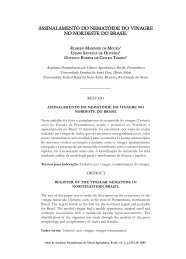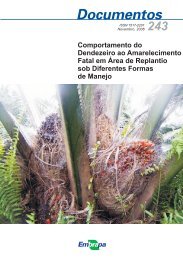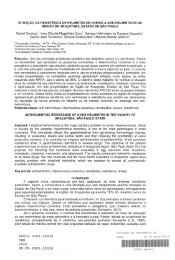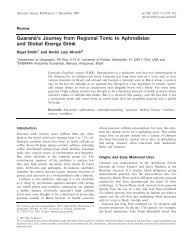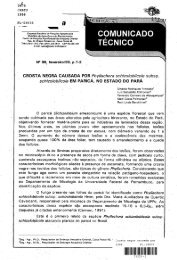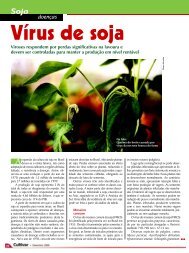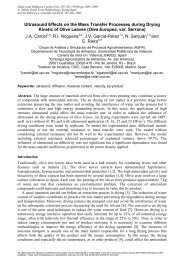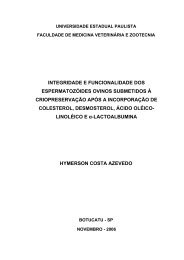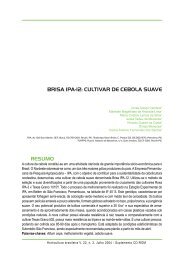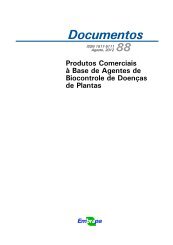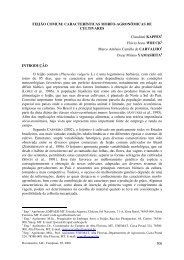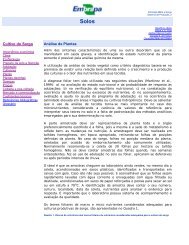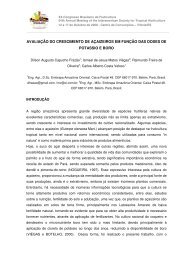Comportamento de Cultivares de Arroz no Estado .do ... - Embrapa
Comportamento de Cultivares de Arroz no Estado .do ... - Embrapa
Comportamento de Cultivares de Arroz no Estado .do ... - Embrapa
Create successful ePaper yourself
Turn your PDF publications into a flip-book with our unique Google optimized e-Paper software.
03253<br />
CPAF-AP<br />
1996<br />
Número 15<br />
ISSN<br />
<strong>Comportamento</strong> <strong>de</strong><br />
<strong>Cultivares</strong> <strong>de</strong> <strong>Arroz</strong> <strong>no</strong><br />
<strong>Esta<strong>do</strong></strong> <strong>do</strong> Amapá<br />
em 1994 e 1995<br />
Em,a<br />
<strong>Comportamento</strong> <strong>de</strong> cultivares <strong>de</strong> ssenquissAgropnuj,I.<br />
1996 - FL jjjo<br />
ds. Agroflor.stal <strong>do</strong> Amapá<br />
1101 UII 101 IkI IW II 010 0I II<br />
28684<br />
ricu/tu,ae<strong>do</strong> Abastecimento
REPÚBLICA FEDERATIVA DO BRASIL<br />
Presi<strong>de</strong>nte da República<br />
Fernan<strong>do</strong> Henrique Car<strong>do</strong>so<br />
Ministério da Agricultura e <strong>do</strong> Abastecimento - MA<br />
Ministro<br />
Arlin<strong>do</strong> Porto Neto<br />
Empresa Brasileira <strong>de</strong> Pesquisa Agropecuária - <strong>Embrapa</strong><br />
Presi<strong>de</strong>nte<br />
Alberto Duque Portugal<br />
Diretores<br />
José Roberto Rodrigues Peres<br />
Elza Angela Battaggia Brito da Cunha<br />
Dante Daniel Giacomelli Scolari<br />
Chefia <strong>do</strong> CPAF - Amapá<br />
Emanuel da Silva Cavalcante - Chefe Geral<br />
Robério Aleixo Anselmo Nobre - Chefe Adjunto Técnico<br />
Mário Alves <strong>de</strong> Mace<strong>do</strong> - Chefe Adjunto <strong>de</strong> Apoio
BOLETIM DE PESQUISA; ftP 15<br />
ISSN 1413- 3768<br />
Abril, 1996<br />
<strong>Comportamento</strong> <strong>de</strong> <strong>Cultivares</strong> <strong>de</strong><br />
<strong>Arroz</strong> <strong>no</strong> <strong>Esta<strong>do</strong></strong> .<strong>do</strong> Amapá<br />
em 1994 e 1995<br />
<strong>Embrapa</strong> - SP!<br />
Brasilia, DF<br />
1996<br />
André Luiz Atmob<br />
Emanue! da Silva Cavalcante
Exemplares <strong>de</strong>sta publicação po<strong>de</strong>m ser solIcIta<strong>do</strong>s à:<br />
<strong>Embrapa</strong> - CPAF - Amapá<br />
Ro<strong>do</strong>via Jusceli<strong>no</strong> Kubitschek, Km 5<br />
Fones: (096) 241-1551 e 241-1480<br />
Fax: (096) 241-1480<br />
Caixa Postal 10, CEP 68902-280 Macapá - AP<br />
Comitê <strong>de</strong> Publicações <strong>do</strong> CPAF - Amapá<br />
Raimun<strong>do</strong> Pinheiro Lopes Filho - Presi<strong>de</strong>nte<br />
André Luiz Atroch<br />
Emanuel da Silva Cavalcante<br />
Jorge Fe<strong>de</strong>rico Oreilana Segovia<br />
Maria Goretti Gurgel Praxe<strong>de</strong>s - Normalização<br />
Suas Mochiutti<br />
Composição<br />
Joana DArc Souza Bezerra Queiroz (CPAF - Amapá)<br />
Produção, Impressão e Acabamento:<br />
Serviço <strong>de</strong> Produção <strong>de</strong> Informação - SPI<br />
Coor<strong>de</strong>nação Editorial<br />
Marina A. Souza <strong>de</strong> Oliveira e Araquem CalMo Motta<br />
Copy Desk e Revisão <strong>de</strong> Texto<br />
Francisco C. Martins<br />
Diagramação Eletrônica<br />
José Batista Dantas<br />
Tiragem: 150 exemplares<br />
ATROCI-?, A.L; CAVALCANTE, E. das. <strong>Comportamento</strong> <strong>de</strong><br />
cultivares <strong>de</strong> arroz <strong>no</strong> <strong>Esta<strong>do</strong></strong> <strong>do</strong> Amapá em 1994 e<br />
1995. Brasília: <strong>Embrapa</strong> - SPI / Macapá: <strong>Embrapa</strong> - CPAF-<br />
Amapá, 1996. 21p. (<strong>Embrapa</strong> - CPAF-AMAPÁ. Boletim<br />
<strong>de</strong> Pesquisa, 15).<br />
ISSN 141 3-3768.<br />
1. <strong>Arroz</strong> - Cultivo - Brasil - Amapá. 1. Cavalcante, E. da<br />
S. II. <strong>Embrapa</strong>. Centro <strong>de</strong> Pesquisa Agroflorestai <strong>do</strong> Amapá<br />
(Macapá, AP). III. Título. IV- Série.<br />
CDD 633.18<br />
© <strong>Embrapa</strong> 1996
Agra<strong>de</strong>cimentos<br />
Aos pesquisa<strong>do</strong>res Suas Mochiutti, pelas sugestões na elaboração<br />
e análises estatísticas e Raimun<strong>do</strong> Pinheiro Lopes Filho, pela ajuda na<br />
elaboração <strong>do</strong>s subprojetos que <strong>de</strong>ram origem aos resulta<strong>do</strong>s ora<br />
apresenta<strong>do</strong>s.<br />
O <strong>de</strong>senvolvimento <strong>de</strong>ste trabalho foipossível graças a uma equipe<br />
<strong>de</strong> apoio técnico que sempre se <strong>de</strong>dicou com zelo às ativida<strong>de</strong>s<br />
<strong>de</strong>senvolvidas. Deste mo<strong>do</strong>, queremos expressar <strong>no</strong>ssos agra<strong>de</strong>cimentos<br />
ao assistente <strong>de</strong> pesquisa Izaque <strong>de</strong> Nazaré Pinheiro e a toda a equipe<br />
<strong>de</strong> trabalho <strong>do</strong> Campo Experimental <strong>de</strong> Mazagão.<br />
Os autores
Resumo .<br />
Abstract .<br />
Introdução ........................<br />
Materiat e Méto<strong>do</strong>s ..........<br />
Resulta<strong>do</strong>s e Discussão<br />
Conclusão ........................<br />
Referências Bibliográficas<br />
t4 cada passo, a busca da perfeição é constante*<br />
CQT/AP
COMPORTAMENTO DE CULTIVARES DE ARROZ<br />
NO ESTADO DO AMAPÁ EM 1994 E 1995<br />
André Luiz Atroch<br />
Emanuel da Silva Cavalcantez<br />
RESUMO - No perlo<strong>do</strong> <strong>de</strong> 1993/94 a 1994/95, foram conduzi<strong>do</strong>s sete ensaios <strong>de</strong><br />
avaliação <strong>de</strong> linhagens e cultivares <strong>de</strong> arroz para os ecossistemas <strong>de</strong> mata <strong>de</strong> terra<br />
firme (floresta tropical <strong>de</strong>nsa) e várzea. Parâmetros <strong>de</strong> floração média, altura <strong>de</strong> plantas,<br />
índice <strong>de</strong> acamamento, reação às principais <strong>do</strong>enças e produtivida<strong>de</strong> foram avalia<strong>do</strong>s<br />
em <strong>de</strong>lineamento experimental <strong>de</strong> blocos ao acaso. A qualida<strong>de</strong> <strong>do</strong>s grãos foi também<br />
observada como fator <strong>de</strong> seleção <strong>do</strong>s materiais testa<strong>do</strong>s. Para o sistema <strong>de</strong> cultivo <strong>de</strong><br />
sequeiro favoreci<strong>do</strong> as linhagens CNA 6843-1, BSL, CT 7115, L 141, CNA 7460 e<br />
CNA 7706 e as cultivares Araguaia e Progresso foram selecionadas como promissoras<br />
para a região. Em condições <strong>de</strong> várzea úmida, a linhagem CNA 6343 possui bom<br />
potencial para ser cultivada em plantios comerciais.<br />
Termos para in<strong>de</strong>xação: arroz, cultivares, avaliação, seleção, linhagem.<br />
PERFORMANCE OF RICE VARIETIES<br />
IN STATE OF AMAPA IN 1994 AND 1995<br />
ABSTRACT - In periods 1993194 and 1994/95 were carried out seven evaluation trials<br />
with lines and varieties ofrice suitable for both forest land (upland) and humid areas<br />
(lowland) ecossystems. Parameters based on fiowering, height ofplants, resistence to<br />
main disease and productivity were evaluated through a ran<strong>do</strong>mized complete block<br />
<strong>de</strong>sign. Grain quality was also used as a factor for selecting the studied lines lii dry<br />
areas cultivation un<strong>de</strong>r favourable conditions, the lines CNA 6843.1, BSL, CT 7/15,<br />
L 141, CNA 7460, CNA 7706 and varieties Araguaia and Progresso were selected as<br />
promissing materiaIs to be used by regional farmers. In humid areas (lowland), the<br />
une CNA 6343 <strong>de</strong>monstred to have a potential for commercial cultivation.<br />
In<strong>de</strong>x terms: rice, evaluation, selection, lines, cultivars.<br />
Eng. Âgr., <strong>Embrapa</strong>/Centro <strong>de</strong> Pesquisa Agroflorestal <strong>do</strong> Amapá (CPAF-Arnapá), Caixa Postal 10,<br />
CEP 68902-280. Macapá - AP.<br />
2 Eng. Agr., M.Sc., <strong>Embrapa</strong> (CPAF - Amapá).
INTRODUÇÃO<br />
A produção <strong>de</strong> arroz <strong>no</strong> <strong>Esta<strong>do</strong></strong> <strong>do</strong> Amapá aten<strong>de</strong> apenas 5,5% das necessida<strong>de</strong>s<br />
<strong>do</strong> merca<strong>do</strong> local. Tal situação <strong>de</strong>corre <strong>do</strong> sistema <strong>de</strong> cultivo pre<strong>do</strong>minantemente<br />
utiliza<strong>do</strong> (sequeiro), o qual tem apresenta<strong>do</strong> baixa produtivida<strong>de</strong>. A disponibilida<strong>de</strong><br />
<strong>de</strong>, aproximadamente, 600 mil hectares <strong>de</strong> várzeas aptas a urna orizicultura intensiva,<br />
se convenientemente exploradas, po<strong>de</strong>ria contribuir para o aumento da produção<br />
estadual <strong>de</strong>ste cereal.<br />
O cultivo <strong>do</strong> arroz <strong>no</strong> <strong>Esta<strong>do</strong></strong> <strong>do</strong> Amapá é feito basicamente em pequenas<br />
proprieda<strong>de</strong>s rurais, on<strong>de</strong> cada produtor planta, em média, 2ha. O sistema <strong>de</strong> cultivo<br />
<strong>de</strong> sequeiro, em áreas <strong>de</strong> mata <strong>de</strong> terra firme (floresta tropical <strong>de</strong>nsa) consiste <strong>no</strong> preparo<br />
<strong>de</strong> área característico da Região Norte, com as operações <strong>de</strong> broca, <strong>de</strong>rruba, coivara e<br />
queima <strong>no</strong>s meses <strong>de</strong> outubro e <strong>no</strong>vembro. A partir <strong>do</strong>s meses <strong>de</strong> <strong>no</strong>vembro até janeiro<br />
e, em alguns casos, fevereiro, realiza-se o plantio. No caso <strong>de</strong> cultivo em várzea, o<br />
plantio <strong>de</strong>ve ser realiza<strong>do</strong> até o mês <strong>de</strong> <strong>de</strong>zembro. As cultivares atualmente plantadas<br />
são a IAC 47 e as tradicionais Agulhinha, Trinca-ferro, Canela-<strong>de</strong>-ferro e algumas não<br />
i<strong>de</strong>ntificadas, além da cultivar Xingu, que respon<strong>de</strong> por mais <strong>de</strong> 50% da área plantada<br />
com arroz. Em várzea, apesar da recomendação das cultivares Ajuricaba e Cica 8, as<br />
cultivares utilizadas são as mesmas <strong>do</strong> sistema <strong>de</strong> cultivo em sequeiro, ten<strong>do</strong> como<br />
conseqüência gran<strong>de</strong>s perdas <strong>de</strong> produção por acamamento das plantas. A área colhida<br />
<strong>no</strong> <strong>Esta<strong>do</strong></strong> <strong>do</strong> Amapá foi, em 1994, <strong>de</strong> 425ha, com uma produção <strong>de</strong> 343t e rendimento<br />
médio <strong>de</strong> 807kg/lia, sen<strong>do</strong> este rendimento 14,63% maior <strong>do</strong> que o rendimento <strong>de</strong><br />
1993 (Levantamento.., 1994).<br />
Diversos autores indicam que a substituição das cultivares tradicionais por<br />
materiais melhora<strong>do</strong>s representam um incremento muito gran<strong>de</strong>, em termos <strong>de</strong><br />
produtivida<strong>de</strong>. Atroch (1993a) comparan<strong>do</strong> o <strong>de</strong>sempenho <strong>de</strong> 20 genótipos <strong>de</strong> arroz<br />
em condições <strong>de</strong> sequeiro, encontrou cinco materiais com produtivida<strong>de</strong>s superiores à<br />
cultivar BR 4, utilizada como testemunha local, sen<strong>do</strong> que a cultivar Xingu alcançou a<br />
maior produtivida<strong>de</strong> (2.82 lkg/ha). Este resulta<strong>do</strong> ensejou a recomendação da cultivar<br />
Xingu para plantios comerciais em áreas <strong>de</strong> mata <strong>de</strong> terra firme <strong>no</strong> esta<strong>do</strong> (Atroch,<br />
1993b).<br />
Sanches, cita<strong>do</strong> por Sousa (1988), relata que a substituição <strong>de</strong> cultivares <strong>de</strong> porte<br />
alto suscetíveis ao acamamento, por cultivares <strong>de</strong> porte baixo resistentes ao acamamento,<br />
tem incrementa<strong>do</strong> substancialmente o rendimento em nível <strong>de</strong> produtor.<br />
Mascarenhas et ai. (1981) cita que a substituição da cultivar IAC 1246,<br />
tradicionalmente cultivada em regime <strong>de</strong> sequeiro em Roraima, pela IAC 5128 ou<br />
IAC 165, permitiria um incremento <strong>de</strong> produtivida<strong>de</strong> <strong>de</strong> grãos da or<strong>de</strong>m <strong>de</strong> 20%.<br />
Sousa & Campos (1985) <strong>no</strong> <strong>Esta<strong>do</strong></strong> <strong>do</strong> Acre e Sobral et ai. (1984) em Rondônia,<br />
em ensaios <strong>de</strong> avaliação <strong>de</strong> cultivares/linhagens <strong>de</strong> arroz, i<strong>de</strong>ntificaram genótipos com
produtivida<strong>de</strong>s <strong>de</strong> grãos superiores em até 200% às das cultivares tradicionalrnente<br />
utilizadas nesses esta<strong>do</strong>s.<br />
Em condições <strong>de</strong> várzea úmida, Atroch (1993c), comparan<strong>do</strong> 36 genótipos,<br />
selecio<strong>no</strong>u os materiais CNA 6326 (9.407kg/ha), CNA 6284 (5.5661cg/ha), CNA 6730<br />
(5.467kg/ha) e CICA 8(5.180kg/lia).<br />
No <strong>Esta<strong>do</strong></strong> <strong>do</strong> Maranhão, num ensaio <strong>de</strong> observação <strong>de</strong> genótipos <strong>de</strong> arroz em<br />
várzea úmida, Yokokura (1993a) selecio<strong>no</strong>u, <strong>no</strong> a<strong>no</strong> agricola 1991192, materiais<br />
promissores que se <strong>de</strong>stacaram em termos <strong>de</strong> ciclo, acamamento, pragas, <strong>do</strong>enças e<br />
produtivida<strong>de</strong>. No mesmo a<strong>no</strong> agrícola, num ensaio comparativo preliminar com 36<br />
genótipos, <strong>de</strong>tectou-se que 53% <strong>de</strong>les superaram em produtivida<strong>de</strong> a testemunha local<br />
Mearim, <strong>de</strong>stacan<strong>do</strong>-se sete genótipos, cujas produtivida<strong>de</strong>s variaram <strong>de</strong> 3.21 6kg/lia a<br />
3.685kg/lia (Yokokura, 1993b).<br />
MATERIAL E MÉTODOS<br />
No perío<strong>do</strong> <strong>de</strong> 1994 a 1995, foram conduzi<strong>do</strong>s sete ensaios <strong>de</strong> avaliação <strong>de</strong><br />
cultivares e linhagens <strong>de</strong> arroz, sen<strong>do</strong> quatro ensaios <strong>no</strong> sistema <strong>de</strong> cultivo <strong>de</strong> sequeiro<br />
favoreci<strong>do</strong> em áreas <strong>de</strong> mata <strong>de</strong> terra firme (floresta tropical <strong>de</strong>nsa) e três ensaios <strong>no</strong><br />
sistema <strong>de</strong> cultivo em várzea úmida em áreas <strong>de</strong> mata <strong>de</strong> várzea.<br />
Os ensaios foram conduzi<strong>do</strong>s em Mangão, AP, localiza<strong>do</strong> a 0 0 7' <strong>de</strong> latitu<strong>de</strong><br />
Sul, 51° 17' <strong>de</strong> longitu<strong>de</strong> Oeste e 15m <strong>de</strong> altitu<strong>de</strong>. O clima é <strong>do</strong> tipo Ami, segun<strong>do</strong> a<br />
classificação <strong>de</strong> Kbppen, temperatura média anual <strong>de</strong> 27°C, umida<strong>de</strong> relativa <strong>do</strong> ar <strong>de</strong><br />
82% e precipitação pluviométrica anual <strong>de</strong> 2.300mm, com as chuvas distribuídas <strong>de</strong><br />
<strong>de</strong>zembro ajulho.<br />
As cultivares e linhagens avaliadas foram provenientes <strong>do</strong> Centro Nacional <strong>de</strong><br />
Pesquisa <strong>de</strong> <strong>Arroz</strong> e Feijão - CNPAF. No a<strong>no</strong> <strong>de</strong> 1994, conduziu-se um ensaio<br />
comparativo preliminar <strong>de</strong> arroz <strong>de</strong> várzea úmida, um ensaio comparativo avança<strong>do</strong><br />
<strong>de</strong> arroz <strong>de</strong> várzea úmida, <strong>do</strong>is ensaios comparativos preliminares <strong>de</strong> arroz <strong>de</strong> sequeiro<br />
favoreci<strong>do</strong>, sen<strong>do</strong> um <strong>de</strong> arroz <strong>de</strong> ciclo precoce e outro <strong>de</strong> ciclo médio, e um ensaio<br />
avança<strong>do</strong> <strong>de</strong> arroz <strong>de</strong> sequeiro favoreci<strong>do</strong>. No a<strong>no</strong> <strong>de</strong> 1995, foram conduzi<strong>do</strong>s um<br />
ensaio comparativo avança<strong>do</strong> <strong>de</strong> arroz <strong>de</strong> várzea úmida e um ensaio comparativo<br />
avança<strong>do</strong> <strong>de</strong> arroz <strong>de</strong> sequeiro favoreci<strong>do</strong>.<br />
Os genótipos seleciona<strong>do</strong>s <strong>no</strong>s ensaios preliminares passaram a constituir os<br />
ensaios avança<strong>do</strong>s <strong>do</strong> a<strong>no</strong> seguinte, sen<strong>do</strong> que os melhores materiais <strong>de</strong>vem permanecer<br />
nestes por um perío<strong>do</strong> mínimo <strong>de</strong> <strong>do</strong>is a<strong>no</strong>s, para serem indica<strong>do</strong>s como <strong>no</strong>va cultivar<br />
para plantio comercial.
O <strong>de</strong>lineamento experimental <strong>de</strong> blocos ao acaso foi utiliza<strong>do</strong> em to<strong>do</strong>s os ensaios.<br />
Os parâmetros avalia<strong>do</strong>s foram floração média, altura <strong>de</strong> plantas, acamamento, <strong>do</strong>enças<br />
e produtivida<strong>de</strong>. As características da qualida<strong>de</strong> <strong>do</strong>s grãos são feitas <strong>no</strong> CNPAF e têm<br />
servi<strong>do</strong> como parâmetro <strong>de</strong> seleção quan<strong>do</strong> o material passa por to<strong>do</strong> o screening<br />
anterior e toma-se potencial para o lançamento.<br />
Ensaio comparativo preliminar <strong>de</strong> arroz em várzea úmida - 1993194<br />
Este ensaio foi instala<strong>do</strong> <strong>no</strong> dia 18.01.94, em solo Gley Pouco Húmico (GPH)<br />
cuja análise mostrou os seguintes resulta<strong>do</strong>s: pH = 5,7; AI = 0,3 meq/lOOcm'; AI + H<br />
= 6,1meq/100cm 3; Ca = 5,4meq/100cm 3; Ca + Mg = 10,9 meq/100cm 3; P = 15ppm;<br />
K = 47ppm e M.O. = 3,70%. Aplicou-se, aos 40 dias após o plantio, 31 ,Skg/ha <strong>de</strong> N,<br />
utilizan<strong>do</strong>-se como fonte a uréia.<br />
Foram avalia<strong>do</strong>s 30 materiais dispostos num <strong>de</strong>lineamento experimental <strong>de</strong> blocos<br />
ao acaso, com quatro repetições. O plantio foi executa<strong>do</strong> <strong>no</strong> espaçamento <strong>de</strong><br />
0,25m x 0,25m, com cinco sementes por cova. A parcela foi constituída <strong>de</strong> cinco<br />
linhas <strong>de</strong> 5,00m <strong>de</strong> comprimento, perfazen<strong>do</strong> uma área total <strong>de</strong> 6,25m 2. A área útil da<br />
parcela era constituída das três linhas centrais <strong>de</strong> 4,00m <strong>de</strong> comprimento, totalizan<strong>do</strong><br />
3,00m2 .<br />
Ensaio comparativo avança<strong>do</strong> <strong>de</strong> arroz em várzea úmida - 1993194<br />
Foi instala<strong>do</strong> <strong>no</strong> dia 18.01.94, em solo GPH, cuja análise revelou os seguintes<br />
resulta<strong>do</strong>s: pH = 5,6; AI = 0,3meq/100cm 3; Ca = 4,6meq/100cm 3; Ca + Mg =<br />
10,4meqf 100cm 3; P = 7ppm; K = 55ppm e M.O. = 2,99%. Aplicou-se, aos 40 dias<br />
após o plantio, 31 ,5kg/ha <strong>de</strong> N, utilizan<strong>do</strong>-se como fonte a uréia.<br />
Foram avalia<strong>do</strong>s 20 materiais dispostos num <strong>de</strong>lineamento experimental <strong>de</strong> blocos<br />
ao acaso, com quatro repetições. O espaçamento utiliza<strong>do</strong> foi <strong>de</strong> 0,25m x 0,25m, com<br />
cinco sementes por cova. A parcela era composta <strong>de</strong> seis linhas <strong>de</strong> 5,00m <strong>de</strong><br />
comprimento, perfazen<strong>do</strong> uma área total <strong>de</strong> 7,50m 2. A área útil foi constituída das<br />
quatro linhas centrais <strong>de</strong> 4,00m <strong>de</strong> comprimento, totalizan<strong>do</strong> 4,00m 2 .<br />
Ensaio comparativo preliminar <strong>de</strong> arroz <strong>de</strong> sequeiro favoreci<strong>do</strong> - ciclo precoce -<br />
1993/94<br />
Ensaio instala<strong>do</strong> <strong>no</strong> dia 09.02.94, num Latossolo Amarelo, cuja análise mostrou<br />
os seguintes resulta<strong>do</strong>s: p11 = 5,6; P = 1 lppm e M.O. = 3,34%. A adubação constou <strong>de</strong><br />
lOkg/ha <strong>de</strong> N (sulfato <strong>de</strong> amônia), 60kg/lia <strong>de</strong> P 205 (superfosfato triplo) e 30kg/ha <strong>de</strong><br />
1(20 (cloreto <strong>de</strong> potássio) <strong>no</strong> sulco <strong>de</strong> plantio, 5cm abaixo das sementes e <strong>de</strong> 30kg/ha<br />
<strong>de</strong> N (uréia), em cobertura, 40 dias após o plantio.<br />
10
Foram avalia<strong>do</strong>s 30 materiais num <strong>de</strong>lineamento experimental <strong>de</strong> blocos ao acaso,<br />
com três repetições. O plantio foi realiza<strong>do</strong> em sulcos espaça<strong>do</strong>s <strong>de</strong> 0,40m numa<br />
<strong>de</strong>nsida<strong>de</strong> <strong>de</strong> 60 sementes por metro linear. A parcela era constituída <strong>de</strong> quatro linhas<br />
<strong>de</strong> 5,00m <strong>de</strong> comprimento, totalizan<strong>do</strong> 8,00m 2. A área útil da parcela era constituída<br />
pelas duas linhas centrais, <strong>de</strong>ixan<strong>do</strong>-se 0,50m nas extremida<strong>de</strong>s, perfazen<strong>do</strong> 3,20m 2 .<br />
Ensaio comparativo preliminar <strong>de</strong> arroz <strong>de</strong> sequeiro favoreci<strong>do</strong> - ciclo médio -<br />
1993/94<br />
Foi instala<strong>do</strong> <strong>no</strong> mesmo dia e com o mesmo méto<strong>do</strong> <strong>do</strong> ensaio preliminar <strong>de</strong><br />
ciclo precoce.<br />
Ensaio comparativo avança<strong>do</strong> <strong>de</strong> arroz <strong>de</strong> sequeiro favoreci<strong>do</strong> - 1993194<br />
Este ensaio foi instala<strong>do</strong> <strong>no</strong> dia 25.02.94, num Latossolo Amarelo, cuja análise<br />
mostrou os seguintes resulta<strong>do</strong>s: pH = 5,6; P = 1 lppm e M.O. = 3,34%. A adubação<br />
constou <strong>de</strong> lOkg/ba <strong>de</strong> N (sulfato <strong>de</strong> amônia), óOkg/ha <strong>de</strong> P 20 5 (superfosfato triplo) e<br />
30kg/ha <strong>de</strong> K 20 (cloreto <strong>de</strong> potássio) <strong>no</strong> sulco <strong>de</strong> plantio, 5cm abaixo das sementes e<br />
<strong>de</strong> 30kg/ha <strong>de</strong> N (uréia), em cobertura, 40 dias após o plantio.<br />
Foram avalia<strong>do</strong>s 28 materiais num <strong>de</strong>lineamento experimental <strong>de</strong> blocos ao acaso,<br />
com quatro repetições. O plantio foi realiza<strong>do</strong> em sulcos espaça<strong>do</strong>s <strong>de</strong> 0,40m numa<br />
<strong>de</strong>nsida<strong>de</strong> <strong>de</strong> semeadura <strong>de</strong> 60 sementes por metro linear. A parcela foi composta <strong>de</strong><br />
cinco linhas <strong>de</strong> 5,00m <strong>de</strong> comprimento, totalizan<strong>do</strong> 10,00m 2. A área útil da parcela era<br />
constituída pelas três linhas centrais, <strong>de</strong>ixan<strong>do</strong>-se 0,50m nas extremida<strong>de</strong>s, perfazen<strong>do</strong><br />
4,80m2.<br />
Ensaio comparativo avança<strong>do</strong> <strong>de</strong> arroz <strong>de</strong> várzea úmida - 1994195<br />
Foi instala<strong>do</strong> <strong>no</strong> dia 13.12.94, numa área <strong>de</strong> várzea <strong>do</strong> Campo Experimental <strong>de</strong><br />
Mazagão, em solo Clley Pouco Húmico, cuja análise mostrou os seguintes resulta<strong>do</strong>s:<br />
p11 = 5,6; Al
Ensaio comparativo avança<strong>do</strong> <strong>de</strong> arroz <strong>de</strong> sequeiro favoreci<strong>do</strong> - 1994195<br />
Este ensaio foi instala<strong>do</strong> <strong>no</strong> dia 27.02.95, <strong>no</strong> Campo Experimental <strong>de</strong> Mazagão<br />
- AP, num Latosso Amarelo, textura média, cuja análise revelou os seguintes resulta<strong>do</strong>s:<br />
pH = 5,6; AI = 0,8meq/100cm 3; II = 12,87meq/100cm'; Ca+Mg = 3,13meq/100cm';<br />
P = 4ppm; K 6 lppm; M.0. = 3,60% e classificação textural franco-argiloso. O preparo<br />
mecaniza<strong>do</strong> <strong>do</strong> soto constou <strong>de</strong> aração e gradagem. A adubação constou <strong>de</strong> IOkg/ha<br />
<strong>de</strong> N (sulfato <strong>de</strong> amônia), 60kg/ha <strong>de</strong> P205 (superfosfato triplo) e 30kg/ha <strong>de</strong> K 20<br />
(cloreto <strong>de</strong> potássio) por ocasião <strong>do</strong> plantio e <strong>de</strong> 30kg/ha <strong>de</strong> N (uréia) em cobertura, 45<br />
dias após o plantio.<br />
Foram avalia<strong>do</strong>s 26 materiais, incluin<strong>do</strong> a testemunha local Xingu, num<br />
<strong>de</strong>lineamento experimental <strong>de</strong> blocos ao acaso, com quatro repetições. A parcela foi<br />
constituída <strong>de</strong> cinco linhas <strong>de</strong> 5,00m <strong>de</strong> comprimento, espaçadas <strong>de</strong> 0,30m entre sulcos,<br />
totalizan<strong>do</strong> 7,50m 2. A área útil da parcela foi constituída das três linhas centrais,<br />
<strong>de</strong>ixan<strong>do</strong>-se 0,50m nas extremida<strong>de</strong>s, totalizan<strong>do</strong> 3,60m 2 .<br />
1) A<strong>no</strong> agrícola 1993194:<br />
RESULTADOS E DISCUSSÃO<br />
1.1) Ensaio comparativo preliminar <strong>de</strong> arroz em várzea úmida<br />
Os resulta<strong>do</strong>s obti<strong>do</strong>s neste ensaio mostraram que a produtivida<strong>de</strong> média obtida<br />
foi um pouco baixa, sen<strong>do</strong> este fato atribuí<strong>do</strong> à alta infestação <strong>de</strong> plantas daninhas e<br />
possível carência <strong>de</strong> N e K pelo uso consecutivo por <strong>do</strong>is a<strong>no</strong>s da área experimental.<br />
Destacaram-se os genótipos CNA 7978 (3.541kg/ha), e CNA 7979 (2.997kg/ha) por<br />
reunirem maior número <strong>de</strong> características <strong>de</strong>sejáveis como ciclo médio, boa altura <strong>de</strong><br />
plantas, tolerância ao acamamento e a <strong>do</strong>enças e boa qualida<strong>de</strong> <strong>de</strong> grãos (Tabela 1).<br />
TABELA 1. Da<strong>do</strong>s ohti<strong>do</strong>s <strong>no</strong> ensaio comparativo preliminar <strong>de</strong> arroz <strong>de</strong> várzea<br />
úmida, 1993194. <strong>Embrapa</strong> - CPAF - Amapá, 1996.<br />
Floraçâo Altura Acama- Mancha- Mancha- Brusone- Escalda- Mancha- Produti<br />
Genótípos média <strong>de</strong> mento -parda -estreita -nas- dura-das- -<strong>do</strong>s- vida<strong>de</strong><br />
(dias) plantas (1-9)' (0-9)' (0-9)' -folhas -folhas -grAos (kgflha<br />
(cm) (1-9)' (0-9)' (0-9)'<br />
CNA 7978 89,7a 107,70a 2,0 0.00 0,00 1,00 0,00 0,00 3.541,7<br />
PR306 91,5a 124,04a 1,5 0,00 0,00 1,00 0,00 0,00 3.441,2<br />
BRIRGA 409 90,2a 1 l3,85a 3,5 0,00 0,00 1,00 0,00 0,00 3.206,5<br />
CICAS 95,Oa 103,79a 3,0 0,00 0,00 1,00 0,00 0,00 3.113,2<br />
CNA 7979 93,58 104,15a 2,5 0,00 0,00 1,00 0,00 0,00 2.997,5<br />
12
TABELA 1. Continuação.<br />
Floração Altura Acama- Mancha- Mancha- Brusone- Escalda- Mancha- Produti<br />
Genótjpos média <strong>de</strong> monto -parda -estreita -nas- dura-das- -<strong>do</strong>s- vida<strong>de</strong><br />
(dias) plantas (1 -9)' (0-9)' (0-9)' -folhas -folhas -grãos (kg/ba<br />
(cm) (1 -9) (0-9)' (0-9)<br />
CNA7809 87,Oa 101,69a 3,5 0,00 0.00 1,00 0,00 0,00 2.917,7<br />
1R0A440223621F1 82,5a 97,35a 4,5 0,00 0,00 1,00 0,00 0,00 2.883,0<br />
lR0A44022441F1 94,5a 99,70a 3,0 0.00 0,00 1,00 0,00 0,00 2.816,2<br />
CNA6792 92,7a 1 10,85a 2,5 0,00 0,00 1,00 0,00 0,00 2.698,7<br />
IACI311 90,5a 112,95a 3,0 0,00 0,00 1,00 0,00 0,00 2.587,0<br />
CNA6370 96,Oa 109,14a 1,5 0,00 0,00 1,00 0,00 0,00 2.481,0<br />
CNA7818 89,5a 107,35a 1,0 0.00 0,00 1,00 0,00 0,00 2.470,2<br />
CNA7850 88,2a 105,35a 3,0 0,00 0,00 1,00 0,00 0,00 2.450,5<br />
CNA7981 84,7a 108,90a 1.0 0,00 0,00 1.00 0,00 0,00 2.189,5<br />
PR349 68,5a 87,79a 0,7 0,00 0,00 1,00 0,00 0,00 2.120,2<br />
CNA7849 69,Oa 76,20a 0,7 0,00 0.00 1,00 0,00 0,00 2.032,5<br />
CNA7964 87,7a 100,95a 1,0 0.00 0,00 1,00 0,00 0,00 1.930,2<br />
PR331 72,7a 94,19a 0.7 0,00 0,00 1,00 0,00 0,00 1.888,5<br />
PR308 87,03 94,00a 2,0 0.00 0,00 1,00 0,00 0,00 1.835,0<br />
CNA7847 63,7a 81,60a 0,7 0,00 0,00 1,00 0.00 0,00 1.773,2<br />
CNA7853 63,73 68,74a 0,7 0,00 0,00 1,00 0,00 0,00 1.711,2<br />
CNA7963 92,Oa 104,65a 2,0 0,00 000 1,00 0,00 0,00 1.682,5<br />
1RGA44024111F1 88,2a 98,75a 2,0 0,00 0,00 1,00 0,00 0,00 1.670,0<br />
CNA7826 68,5a 73,94a 2,2 0,00 0,00 1,00 0,00 0,00 1.397,5<br />
CNA7968 81,0a 96,20a 1,5 0,00 0,00 1,00 0,00 0,00 1.240,7<br />
CT6910 64,5a 72,00a 0,7 0,00 0,00 1,00 0,00 0,00 1.224,0<br />
1RGA44022421F1 41,7a 52,25a 2,5 0,00 0,00 1,00 0,00 0,00 1.203,0<br />
1RGA44024111F2 59,2a 67,29a 1,7 0,00 0,00 1,00 000 0,00 979,7<br />
CNA7971 79,7a 95,20a 3,0 0,00 0,00 1,00 0,00 0,00 973,2<br />
CNÀ7982 55,2a 62,65a 1,2 0,00 000 1.00 0.00 000 AÇÇ<br />
1.2) Ensaio comparativo avança<strong>do</strong> <strong>de</strong> arroz <strong>de</strong> várzea úmida<br />
Dentre os materiais testa<strong>do</strong>s, <strong>de</strong>stacaram-se as linhagens PR 214 (4.21 lkg/ha),<br />
CNA 6343 (3.952kg/ha), CNA 6363 (3.844kg/ha) e CNA 5129 (3.51 lkg/ha), por<br />
reunirem maior número <strong>de</strong> características <strong>de</strong>sejáveis como ciclo médio, boa altura <strong>de</strong><br />
plantas, tolerância ao acamamento e a <strong>do</strong>enças e boa qualida<strong>de</strong> <strong>de</strong> grãos (Tabela 2).<br />
1.3) Ensaio comparativo preliminar <strong>de</strong> arroz <strong>de</strong> sequeiro favoreci<strong>do</strong> - ciclo precoce<br />
As linhagens CNA 8060 (2.066,6kg/ha), CNA 8052 (2.047,6kg/lia) e IAC 1366<br />
(1.91 3kg/ha) foram selecionadas por apresentarem boa altura <strong>de</strong> plantas, tolerância ao<br />
13
TABELA 2. Da<strong>do</strong>s obti<strong>do</strong>s <strong>no</strong> ensaio comparativo avança<strong>do</strong> <strong>de</strong> arroz <strong>de</strong> várzea<br />
úmida, 1993194. CPAF - Amapá.<br />
Floração Miara Acama- Mancha. Mancha- Brusone- Escalda- Mancha- Produti-<br />
Genótipos média <strong>de</strong> mento -parda -estreita -nas- dura-das- -<strong>do</strong>s- vida<strong>de</strong><br />
(dias) plantas (1-9)' (0-9)' (0-9)' -folhas -folhas -grãos (kg/ba)<br />
(cm) (1.9)' (0-9)' (0-9)'<br />
CNA4783 102,00a 136,39a 1,0 0,00 0,00 1,00 0,00 0,00 4.998,25a<br />
CNA6730 105,25a 105,52bcd 1,5 0,00 0,00 1,00 0,00 0,00 4.408,50ab<br />
PR214 84,00bc 82,60f 5,5 0,00 0,00 1,00 0,00 0,00 4.211,00ab<br />
CNA6368 I01,00a 108,69bcd 1,0 0,00 0,00 1,00 0,00 0,00 4.137,50ab<br />
CNA6343 95,50ab 99,20<strong>de</strong> 1,0 0,00 0,00 1,00 0,00 0,00 3.952,00ab<br />
CNA6363 97,25a 106,00bcd 1,0 0,00 0,00 1,00 0,00 0,00 3.844,25ab<br />
CNA6793 100,75a 117,84b 1,0 0,00 0,00 1,00 0,00 0,00 3.542,00ab<br />
CNA5129 96,25ab 116,69bc 1,0 0,00 0,00 1,00 0,00 0,00 3.511,25ab<br />
MG421 105,25a 147,65a 1,0 0,00 0,00 1,00 0,00 0,00 3.235,50abc<br />
IÀCI3I0 101,75a 105,40bcd 1,0 0,00 0,00 1,00 0,00 0,00 3.169,75abc<br />
CNA6731 95,75ab 105,90bcd 1,0 0,00 0,00 1,00 0,00 0,00 3.071,75abc<br />
CNA6797 105,25a 116,80bc 2,5 0,00 0,00 1,00 0,00 0,00 2.987,50abc<br />
CNA4898 100,00a 103,79cd 1,0 0,00 0,00 1,00 0,00 0,00 2.949,75abc<br />
CNA7581 95,00ab I08,60bcd 1,0 0,00 0,00 1,00 0,00 0,00 2.737,25abc<br />
CNA6798 106,25a 116,84bc 1,5 0,00 0,00 1,00 0,00 0,00 2.505,50abc<br />
M0477 101,00a 1II,I9bcd 1,0 0,00 0,00 1,00 0,00 0,00 2.493,00abc<br />
CICAS 97,75a 99,55<strong>de</strong> 1,5 0,00 0,00 1,00 0,00 0,00 2.177,251,c<br />
DIAMANTE 94,00ab 89,80cf 1,0 0,00 0,00 1,00 0,00 0,00 I.865,25bc<br />
PR265 74,00c 84,50f 3,0 0,00 0,00 1,00 0,00 0,00 613,25c<br />
Média 97,78 108,58 3.179,50<br />
C.V. (%) 4,95 4,75 31,70<br />
* Os me<strong>no</strong>,a valores sio draej.<strong>do</strong>i.<br />
TABELA 3. Da<strong>do</strong>s obti<strong>do</strong>s <strong>no</strong> ensaio comparativo preliminar <strong>de</strong> arroz <strong>de</strong> sequeiro<br />
favoreci<strong>do</strong> - ciclo precoce, 1993194. CPAF - Amapá.<br />
FloraçAo Altura Acama- Mancha- Mancha- Brusone- Escalda- Mancha- Produti-<br />
Genótipos média <strong>de</strong> mento -parda -estreita 'nas- dura-das- -<strong>do</strong>s- vida<strong>de</strong><br />
(dias) plantas (1-9)' (0-9)' (0-9)' 'folhas 'folhas -grãos (kg/ba)<br />
(cm) (19)' (0-9)' (0-9)'<br />
BSI. 833a 82,06j 1.0 0,00 0,00 1.0 0,00 7,0 2.706,Oa<br />
CNÂS070 67,Odcfghi 127,60abc 3,0 0,00 0,00 1,0 0,00 1,3 2.319,6ab<br />
CNA9064 70,0 c<strong>de</strong>f 103,19ghi 1,0 0,00 0,00 1,0 0,00 3,6 2.512,3ab<br />
CAJAFO 78,Oab 129,13ab 1.6 0,00 0,00 1.0 0,00 2,3 2.289,6abc<br />
CNA8057 70,3c<strong>de</strong>f 106,79dcfghi 1,6 0,00 0,00 1,0 0,00 3,0 2.124,Oabc<br />
CNAS060 646cfgbi 103,93ghi 1,6 0,00 0,00 1,0 0,00 2,0 2.066,6abc<br />
CNA8052 73,3bcd 106j3efghi 3,0 0,00 0,00 1,0 0,00 2,3 2.047,6abc<br />
CNA8069 68,0c<strong>de</strong>fgh 1 14,B6abc<strong>de</strong>fgh 2,3 0,00 0,00 1,0 0,00 1,6 2.047,Oabc<br />
IÂCI363 63,3efghi 124,66abc<strong>de</strong>f 3,0 0,00 0,00 1,0 0,00 1,6 1.935,3abc<br />
1AC1366 63,Ofghi 131,53a 3,0 0,00 0,00 1,0 0,00 1,0 1.913,0abc<br />
14
TABELA 3. Continuação.<br />
Floração Altura Acama- Mancha- Mancha- Brusone- Escalda- Mancha- Produti-<br />
Genótipos média <strong>de</strong> monto -partIa -estreita -nas- dura-das- -<strong>do</strong>s- vida<strong>de</strong><br />
(dias) plantas (1-9)' (0-9) (0-9)' -folhas -folhas -grãos (kg/lta)<br />
(cm) (1-9)' (0-9)' (0-9)'<br />
CNA8056 68,0c<strong>de</strong>fgh 99,39ghij 1,0 0,00 0,00 1.0 0,00 1,3 1 ,846,óabc<br />
CNA8074 61,6ghi 118,59abc<strong>de</strong>fg 4,3 0,00 0.00 1,0 0,00 3,6 I.820,6abc<br />
L4C1375 63,3efghí 119,53abc<strong>de</strong>fg 1,6 0,00 0,00 1,0 0,00 1,3 1,780,3abc<br />
1AC1361 63,0fghi 109,131hc<strong>de</strong>fghi 3.0 0,00 0,00 1,0 0,00 3,0 1,741,3abc<br />
CNA8053 63,0fghi 92,53ij 1,6 0,00 0,00 1,0 0,00 3,0 1,725,Oabc<br />
1AC1377 64,Oofghi 10I,46gh1j 1,6 0,00 0,00 1,0 0,00 3,0 1.704,9abc<br />
CNAS075 65,Oefghi 96,80hij 1,6 0.00 0,00 1,0 0,00 3,3 1,546,Oabc<br />
LPARANAIBA 75,3bc 118,39abcdcfg 3,0 0,00 0,00 1,0 0,00 3,6 1,525,6abo<br />
CNA8099 84,3a 126,86abcd 1.6 0,00 0,00 1,0 0,00 3,6 I,516,6abc<br />
CNAS06I 69,0c<strong>de</strong>fg 126,20abo<strong>de</strong> 3,0 0,00 0,00 1,0 0,00 5,0 I,509,Oabc<br />
LkC1213 63,Ofghi 125,19abc<strong>de</strong>f 3,6 0,00 0,00 1,0 0,00 2,0 I486,6abe<br />
CNA8063 70,6bc<strong>de</strong> II 7,66abcdcfg 3,0 0,00 0,00 1,0 0,00 2,6 1 .464,3abc<br />
IÂCI 183 62,3ghi 103,73ghi 3.0 0,00 0,00 1,0 0,00 3,6 1 .359,Oabc<br />
GUARANI 61,6ghi 109,39bcdcfghi 5,0 0,00 0,00 1,0 0,00 3,6 1.326,Oabe<br />
CNA8097 61,0hj 105,46fghi 6,3 0,00 0,00 1,0 0,00 5,6 1,308,3abc<br />
CNA8077 61,6g1d 92,93ij 2,3 0,00 0,00 1,0 0.00 3,6 I.195,6abo<br />
CNAS072 59,6i 103,26ghi 3,0 0,00 0,00 1,0 0,00 3,3 1,085,3abc<br />
CNA8055 61,6ghi 107,80c<strong>de</strong>rghi 5,6 0,00 0,00 1,0 0,00 3,6 I,072,Oabc<br />
CNA8054 70,Oc<strong>de</strong>f 124,39abc<strong>de</strong>f 1,6 OPO 0,00 1,0 0,00 6,3 676,61›c<br />
CNA8073 61,Ohi 90,26ij 2,3 0,00 0,00 1,0 0,00 4.6 537,6c<br />
Média 67.0 110,64 1678,3<br />
CV. (%) 3,43 5,63 34,28<br />
acamamento e <strong>do</strong>enças como mancha-<strong>do</strong>s-grãos, boa produtivida<strong>de</strong> e qualida<strong>de</strong> <strong>de</strong><br />
grãos (Tabela 3).<br />
1.4) Ensaio comparativo preliminar <strong>de</strong> arroz <strong>de</strong> sequeiro favoreci<strong>do</strong> - ciclo médio<br />
CIAT 300 (3.485kg/ha), IAC 1359 (1374,6kg/ha) e IAC 1203 (3.336,3kg/ha)<br />
<strong>de</strong>stacaram-se <strong>no</strong> ensaio por apresentarem resistência ao acamamento, resistência a<br />
tolerância às <strong>do</strong>enças Brusone-nas-folhas, Mancha-<strong>do</strong>s-grãos e Mancha-parda, além<br />
<strong>de</strong> boa produtivida<strong>de</strong> e qualida<strong>de</strong> <strong>de</strong> grãos (Tabela 4).<br />
1.5) Ensaio comparativo avança<strong>do</strong> <strong>de</strong> arroz <strong>de</strong> sequeiro favoreci<strong>do</strong><br />
Neste ensaio, foram seleciona<strong>do</strong>s para reavaliação os materiais CNA 6843-1<br />
(3.842,5kg/ha), BSL (3821kg/ha), CT 7115 (3.479kg/ha), L 141 (3277,5kg/ha),<br />
CNA 6975-2 (1074kg/lia), CLAT 24 (3.003kg/ha), CNA 7926 (2S53kg/ha), CNA<br />
7460 (2.938,75kg/ha), CNA 7706 (2.862,5kg/ha) e CNA 7911 (2340kg/ha)<br />
(Tabela 5).<br />
IS
TABELA t Da<strong>do</strong>s obti<strong>do</strong>s <strong>no</strong> ensaio comparativo preliminar <strong>de</strong> arroz <strong>de</strong> sequeiro<br />
favoreci<strong>do</strong> - ciclo médio, 1993194. CPAF - Amapá.<br />
Floração Altura Acama- Mancha-Mancha-Brusone- Escalda- Mancha- Produti-<br />
(Jenótipos média <strong>de</strong> mento -parda -estreita -nas- dura- -<strong>do</strong>s- vida<strong>de</strong><br />
(dias) plantas (1-9)' (0-9)' (0-9)' -folhas -das- -grãos (kg/ha)<br />
(cm) (1-9)' -folhas (0-9)'<br />
(0-9)'<br />
CIAT300 80,6abcd 109,00c<strong>de</strong> 1,6 0,0 0,00 2,3 0,00 1,0 3.485,0<br />
lACI359 78,Obcd 117,40abc<strong>de</strong> 1,6 0,0 0,00 1,0 0,00 1,3 3374,6<br />
CNA8068 82,6ab 123,93abc<strong>de</strong> 1,6 0,0 0,00 1,6 0,00 0,6 3.361,3<br />
CNAS065 78,0bcd 113,59bc<strong>de</strong> 1,0 2,0 0,00 2,3 0,00 0,0 3.360,3<br />
1AC1203 71,Oef 101,00e 1,0 0,0 0,00 1,0 0,00 0,3 3.336,3<br />
1AC1204 71,Oef 109,00c<strong>de</strong> 2,3 0,0 0,00 1,0 0,00 0,0 3.250,0<br />
L291 82,Oabc 130,86abc 3,6 1,0 0,00 1,0 0,00 0,3 3.225,0<br />
IAC1364 75,3<strong>de</strong> 1I0,46c<strong>de</strong> 1,6 0,3 0,00 1,0 0,00 0,0 3.225,0<br />
CIAT2O 79,3abcd 106,66<strong>de</strong> 1,0 1,0 0,00 3,0 0,00 1,0 3.133,3<br />
CNA8066 76,6c<strong>de</strong> 112,40c<strong>de</strong> 1,0 0,0 0,00 2,3 0,00 0,0 3.011,6<br />
CNA8096 80,6abcd 1II,99c<strong>de</strong> 1,0 0,0 0,00 1,6 0,00 0,0 2.972,6<br />
CNAS095 67,6f 114,93abc<strong>de</strong> 1,0 0,0 0,00 1,6 0,00 0,0 2.925,0<br />
CAIAPO 78,3abcd 136,06ab 3,0 0,0 0,00 1,6 0,00 1,3 2.907,3<br />
CNAS07I 66,0fg 117,33abc<strong>de</strong> 1,6 0,0 0,00 1,6 0,00 0,0 2.878,0<br />
R.PARANAIBA 77,0bcd 132,00abc 2,3 0,0 0,00 1,6 0,00 0,0 2.726,6<br />
CNA8067 82,6ab 106,06<strong>de</strong> 1,0 0,3 0,00 2,3 0,00 0,3 2.637,3<br />
CNA8062 68,0f 116,06abc<strong>de</strong> 2,3 0,0 0,00 1,0 0,00 0,0 2.617,6<br />
L141 80,Oabcd 1I0,66c<strong>de</strong> 1,0 0,0 0,00 1,6 0,00 0,3 2.552.0<br />
CNAS058 67,Of 118,86abc<strong>de</strong> 1,0 0,0 0,00 1,0 0,00 0,0 2.543,6<br />
CNA8078 84,Oa 109,86c<strong>de</strong> 1,0 0,0 0,00 1,0 0,00 2,0 2.518,3<br />
1AC1139 78,0bcd 137,26a 3,6 0,0 0,00 3,0 0,00 0,6 2.465,3<br />
1AC1367 68,Of 114,86abc<strong>de</strong> 2,3 0,0 0,00 1,0 0,00 1,0 2.420,0<br />
1285 81,3abc 127,3iabcd 2,3 0,0 0,00 1,6 0,00 0,6 2.043,0<br />
C .V. (%) 2,42 6,33 24:1<br />
Os me<strong>no</strong>res valores são <strong>de</strong>seja<strong>do</strong>s.<br />
TABELA 5. Da<strong>do</strong>s obti<strong>do</strong>s <strong>no</strong> ensaio comparativo avança<strong>do</strong> <strong>de</strong> arroz <strong>de</strong> sequeiro<br />
favoreci<strong>do</strong>, 1993194. CPAF - Amapá.<br />
Floração Altura Acama- Mancha- Mancha- Brusone- Escalda- Mancha- Produsi'<br />
Genótipos média <strong>de</strong> mento -parda -estreita -nas- dura-das- -<strong>do</strong>s- vida<strong>de</strong><br />
(dias) plantas (1-9) (0-9)' (0-9)' -folhas -folhas -grãos (kglba)<br />
(cm) (1-9)' (0-9)' (0-9)'<br />
CNA6843-1 74,50k 118,15fghi 1,0 1,2 0,00 1,00 2,2 0,2 3.842,50a<br />
BSL 77,75ab 94,04jk 1,0 1,5 0,00 1,00 2.2 1,5 3.821,00a<br />
CT7115 75,00k 109,10hij 1,0 1.0 0,00 1,00 2,7 0,5 3.479,00ab<br />
CNA5598 74,001›c 108,50hij 1,0 2,5 0,00 1,00 3,7 1,7 3.461,50al<br />
CNA7127 75,75ab 120,44<strong>de</strong>fghí 1,0 1.2 0,00 1,00 1,7 0,5 3.368,25ab<br />
L141 77,00ab 119,14efghi 1,0 2,2 0,00 1,00 2,7 0,2 3.277,50ab<br />
R, VERDE 76,50ab 112,901.1 1,0 1,7 0,00 1,00 2,2 1,0 3.207,25abc<br />
16<br />
Continua...
TABELAS. Continuação.<br />
floração Altura Acama- Mancha- Mancha- Bnjsone- Escalda- Mancha- Produti-<br />
Genõtipos média <strong>de</strong> mento -parda -estreita -nas- dura-das- -<strong>do</strong>s- vida<strong>de</strong><br />
(dias) plantas (1-9) (0-9) (0-9) -folhas -folhas -grãos (kgAa)<br />
(cm) (1-9) (0-9) (0-9)<br />
CNA6975-2 83,00a 136,29bcd 3,5 1,5 0.00 1,00 2,7 0,5 3.074,00abcd<br />
CIAT24 74,00be 122,70<strong>de</strong>f'ghi 1,0 2.2 0,00 1,00 3,2 0,5 3.003,00abcd<br />
CNA7926 77,50a1, 109,00hij 1,0 1,2 0,00 1,00 1,2 1,5 2.953,00abc<strong>de</strong><br />
CNA7474 79,50ab 122,85<strong>de</strong>fghi 1.0 1,7 0,00 1,00 3,2 0,2 2.943,50abc<strong>de</strong><br />
CNA7460 78,00ab 1 12,7Ohi 4,0 1,7 0,00 1,00 2,7 0,2 2.938,75abc<strong>de</strong><br />
CNA7706 79,25ab 1 32,Sübc<strong>de</strong>f 1,0 1,7 0,00 1,00 3,2 0,5 2.862,50abc<strong>de</strong><br />
ACREFINO 74,50bc 109,54hij 2,5 0,5 0,00 1,00 2,2 2,7 2.763,50abc<strong>de</strong><br />
CNA79I 1 78,50ab 131,54bc<strong>de</strong>f 4,5 1,2 0,00 1,00 3,2 0,5 2.740,00abc<strong>de</strong><br />
ARAGUAIA 74,001,c 134,70bc<strong>de</strong> 2,0 1.5 0,00 1,00 3,2 1,0 2.686,75abc<strong>de</strong>f<br />
PROGRESSO 75,00be 1 15,3Sghi 1,0 2.7 0,00 1,00 3,7 1,5 2.684,50abc<strong>de</strong>f<br />
XINGU 78,75ab 1 39,75bc 1,0 2,2 0.00 1,00 1,7 1,2 2.633,75abc<strong>de</strong>fg<br />
CÁIAPÕ 78,75a1, 140,991, 3,0 2,7 0,00 1,00 2,2 0,7 2.521,25abc<strong>de</strong>fg<br />
CNA7024 78,75ab 1 62,50a 3.0 1.0 0,00 1,00 1,2 0,2 2.437,25abc<strong>de</strong>fg<br />
CNA6724-1 77,50ab 1 40,74b 4,0 1.7 0,00 1,00 2.2 0,5 2.1 08,Oobe<strong>de</strong>fg<br />
CNA7864 61,75<strong>de</strong>f 130.45be<strong>de</strong>fg 1,0 1,7 0.00 1,00 2.7 0.2 2.093.25bc<strong>de</strong>fg<br />
CARAJÁ5 67,50cd 106,79ijk 1,0 1,0 0,00 1,00 1,7 0,2 1.861 ,O0bc<strong>de</strong>fg<br />
CNA7681 54,001g 123,65cdrfgh 1,0 1,0 0,00 1,00 3,7 0,2 1 .522,Soc<strong>de</strong>fg<br />
CNA7680 62,25<strong>de</strong> II 4,79ghi 1,0 1,5 0,00 1,00 5,7 0,5 1 .483,lS<strong>de</strong>fg<br />
CNA745 1 56,75efg 114,1 Shi 1.5 2.0 0,00 1.00 4,2 1,5 1 .262,25efg<br />
GUARANI 56,00cfg . 1 10,00hij 2,0 0,7 0,00 1.00 2,2 0,2 1 .030,OOfg<br />
IACI 323 53,75g 91,90k 1,0 1.5 0,00 1.00 6,2 0,5 934,75g<br />
Média 72.48 120,90 2.606,93<br />
C.V,(%) 3,91 4,89 .- 23,87<br />
• Os me<strong>no</strong>res valores são <strong>de</strong>seja<strong>do</strong>s.<br />
2) A<strong>no</strong> agrícola 1994195<br />
2.1) Ensaio comparativo avança<strong>do</strong> <strong>de</strong> arroz em várzea úmida<br />
Devi<strong>do</strong> a constantes inundações da área experimental e da alta incidência <strong>de</strong><br />
plantas daninhas, o ensaio foi prejudica<strong>do</strong>, ten<strong>do</strong> como conseqüência a baixa<br />
produtivida<strong>de</strong> obtida (1 .958,2kg/ha).<br />
Analisan<strong>do</strong>-se os resulta<strong>do</strong>s em relação à floração média, observa-se que houve<br />
diferença significativa entre os tratamentos, sen<strong>do</strong> a linhagem CNA 6343 (99,75 dias)<br />
a mais tardia e a CNA 7484 (83,50 dias) a mais precoce. Em relação ao acamamento,<br />
somente a cultivar IRGA 416 apresentou ligeiro índice (1,50), ten<strong>do</strong> os <strong>de</strong>mais obti<strong>do</strong><br />
<strong>no</strong>ta 1,0. Quanto à incidência <strong>de</strong> <strong>do</strong>enças, houve presença <strong>de</strong> Mancha-parda, Mancha-<br />
-estreita, Brusone-nas-folhas e Mancha-<strong>do</strong>s-grãos. A análise <strong>do</strong> parâmetro produtivida<strong>de</strong><br />
mostrou que houve diferença significativa entre os materais testa<strong>do</strong>s, ten<strong>do</strong> a cultivar<br />
BR IRGA 412 (3.294,5kg/ha) obti<strong>do</strong> a maior produtivida<strong>de</strong>, entretanto a mesma só<br />
diferiu da CNA 7968 (1 .049,Skg/ha) e CNA 7484 (776,8kg/ha). Foram seleciona<strong>do</strong>s,<br />
17
para permanecer <strong>no</strong> ensaio, os materiais CNA 6343, CNA7830, CNA6346, PR 268,<br />
IAC 1289 e CNA7857 (Tabela 6).<br />
TABELA 6. Da<strong>do</strong>s obti<strong>do</strong>s <strong>no</strong> ensaio comparativo avança<strong>do</strong> <strong>de</strong> arroz <strong>de</strong> várzea<br />
úmida, 1994195. CPAF - Amapá.<br />
Floração Altura Acama- Mancha- Mancha- Brusone- Escalda- Mancha- Ptoduti-<br />
Genótipos média <strong>de</strong> mento .pards -estreita lias- dura-das- -<strong>do</strong>s- vida<strong>de</strong><br />
(dias) plantas (1-9)' (0-9)' (0-9)' -folhas -folhas -grãos (1cg/1a)<br />
(cm) (1-9)' (0-9)' (0-9)'<br />
BRIRGA4I2 92,00abc<strong>de</strong> 109,90ab 1,00 5.23 0,00 1,00 0,00 2,75 3.294,5a<br />
CNA7979 92,00abc<strong>de</strong> 10I,40abc<strong>de</strong>fgh 1,00 6,00 0,25 1,50 0,00 6,00 3.256,9a<br />
OCAS 97,00ab 103,90abc<strong>de</strong>f 1,00 2,50 2.50 1.00 0,00 3,75 2.844,7ab<br />
CNA6343 99,75a 102,55abc<strong>de</strong>fg 1.00 425 2,50 1,50 0.00 2.75 2,765,8ab<br />
CNA7830 91,50bc<strong>de</strong>f 109,20ab 1,00 3,75 0,00 2,50 0,00 3,75 2.664,6ab<br />
CNA6346 9600ab 103,15abc<strong>de</strong>f 1,00 1,25 1,23 2,50 0,00 5,00 2.515,4ab<br />
PR268 95,50ab 104,85abc<strong>de</strong> 1.00 2,00 1,25 1,00 0,00 4,50 2.462,7ab<br />
CNA7978 93,50abcd 98,25bc<strong>de</strong>fghi 1,00 6,50 1.75 1,50 0,00 500 2,379,5ab<br />
1ÀC1289 93,00abcd II 1,05a 1,00 3,75 3,25 1,00 0,00 3.75 2.361,8ab<br />
CNA7857 94,00abc 95,55c<strong>de</strong>fghi 1,00 3,50 0,75 2.00 0,00 375 2.148,6ab<br />
IRGA4I6 86,00<strong>de</strong>fg 93,10efghi 1,50 6,50 1.25 1,00 0,00 5,50 2.124,9ab<br />
CNA7823 93,00abcd 95,00efghi 1,00 6,00 0,00 1,00 0,00 500 2 .944,7ab<br />
CNA78I9 89,75bc<strong>de</strong>fg 104,20abc<strong>de</strong> 1,00 3,75 0,00 200 0,00 5,00 1.879,Sat,<br />
PR349 91,00bcdcfg 108,65ab 1,00 5,25 2.50 1,00 0,00 3,25 1.725,9ab<br />
DIAMANTE 95,00abc 91,35fghi 1,00 3,75 0,00 1,00 0,00 5,00 I505,4ab<br />
CNA7826 96,00ab 95,35<strong>de</strong>fghi 1,00 5,75 0,00 1,00 0,00 5,00 1.4152ab<br />
CNA5129 95,50ab I08,30abc 1,00 2,50 0,00 1.00 0.00 4,25 1.402,3ab<br />
JAVAE 86,00<strong>de</strong>fg 89,65h1 1,00 6,50 0,00 1.50 0.00 5,50 1.364,2ab<br />
CNA7850 87,50c<strong>de</strong>fg IO285abc<strong>de</strong>f 1,00 5,50 0,00 1,50 0,00 2,50 1.347,7ab<br />
1AC1302 96,75ab 107,95abcd 1,00 5,25 0,00 2,50 0,00 3,75 1.333,7ab<br />
BR.IRGA409 91,50bc<strong>de</strong>f 109,20ab 1,00 3,50 0,00 1,50 0,00 3,75 1.227,5ab<br />
PR214 84,50efg 90,00ghi 1.00 3,25 1,25 1,00 0,00 5,25 1.205,2ab<br />
CNA7968 84,00Ig 89,20hi 1,00 4,25 3,00 4,00 0,00 4,25 1 .049,8b<br />
CNA7484 83,50g 86.201 1,00 4,25 3,75 2,00 0,00 3,00 776,81›<br />
Média 91,84 100,44 1.958,2<br />
C.V. (%) 3,15 4,75 41,46<br />
'Os me<strong>no</strong>res valores são <strong>de</strong>seja<strong>do</strong>s<br />
2.2) Ensaio comparativo avança<strong>do</strong> <strong>de</strong> arroz <strong>de</strong> sequeiro favoreci<strong>do</strong><br />
A Tabela 7 contém os resulta<strong>do</strong>s obti<strong>do</strong>s. Analisan<strong>do</strong>-se o parâmetro floração<br />
média, observa-se que houve diferença significativa (p
TABELA 7. Da<strong>do</strong>s obti<strong>do</strong>s <strong>no</strong> ensaio comparativo avança<strong>do</strong> <strong>de</strong> arroz <strong>de</strong> sequeiro,<br />
1994195. CPAF - Amapá.<br />
floração Aluira Acama- Mancha- Mancha- Brusone- Escalda- Mancha- Ptoduti-<br />
Genótipos média <strong>de</strong> mento -parda -estreita -nas- dura-das- -<strong>do</strong>s- vida<strong>de</strong><br />
(dias) plantas (I-9) (0-9)' (0-9)' -folhas -folhas -grtos (kg/ha)<br />
(cm) (1-9)' (0-9)' (0-9)'<br />
MN-1 69,75c<strong>de</strong>f 101,40<strong>de</strong>fg 1,50 0,00 0,00 1,00 1,00 0,50 3.783,6a<br />
A.RAGUALA 7650abc<strong>de</strong> II835abc<strong>de</strong> 1,00 0,00 0,00 1,00 0.75 0.50 3.529,3ab<br />
1AC1204 65,75ef 109,20bc<strong>de</strong>f 1,00 0,00 0,00 1,00 0,50 1,75 3.454,4ab<br />
1AC1364 73,50bc<strong>de</strong>f 106,85c<strong>de</strong>fg 1,00 0,00 0,00 1,50 2,00 1,25 3.410,9abc<br />
CNA6975-2 86,75 125,95ab 1,00 0,00 0,00 1,00 0,75 0,75 3.211,4abc<br />
CNA7690 74,50bc<strong>de</strong> 126,70ab 1,00 0,00 0,00 1.00 1,50 0,50 3.177,5abc<br />
CT 7/IS 77,00abcd 103,75cdcfg 1,00 0,00 0,00 1,00 2,00 1,00 3.082,labcd<br />
1AC1203 65,75ef 104,30cdcfg 1,00 0,00 0,00 1,50 0.75 2,50 1070,Iabcd<br />
L 141 76,00abc<strong>de</strong> 1 02,2S<strong>de</strong>fg 1,00 0,00 0,00 1,00 0,50 1,00 3,026,8abcd<br />
CNA79I 1 78,50abcd 129,75a 3,00 0,00 0,00 1,00 2,00 1,00 3.009,1abcd<br />
PROGRESSO 78,75abcd 98,65f5 1,00 0,00 0,00 1,00 1,50 0,50 3.000,7abcd<br />
CIAT300 74,50bc<strong>de</strong> 101,00efg 1,00 0,00 0,00 1,00 3,00 1,50 2.934,7abcd<br />
BSL 80,25abc 88,751; 2,50 0,00 0,00 1,00 0,75 2,00 2.901,labcd<br />
CNA6843-I 74,50bc<strong>de</strong> 103,90c<strong>de</strong>fg 1,00 0,00 0,00 1,00 1,50 0.50 2.861,6abcd<br />
1AC1359 72,75be<strong>de</strong>f 119,35abcd 1,50 0,00 0,00 1,00 1,00 1,00 2,858,7abcd<br />
CNA7926 76,50abc<strong>de</strong> 103,65c<strong>de</strong>fg 1,00 0,00 0,00 1,00 0,75 1,75 2.836,Oabcd<br />
1ÀC1205 65,75ef 103,80c<strong>de</strong>fg 2,00 0.00 0,00 1,50 1,50 0.25 2.826,Oabcd<br />
CNA7460 8I,00ab 116,40abc<strong>de</strong>f 2,50 0,00 0,00 1,00 3,00 1,00 2,814,7abcd<br />
CIAT24 72,75bc<strong>de</strong>f 107,70c<strong>de</strong>f 1,00 0,00 0,00 1,00 0,75 0,00 2.782,6abcd<br />
1AC1375 63,50f 1 17,8Oabc<strong>de</strong> 1,00 0,00 0,00 1,00 1,00 0,25 2.731,0abcd<br />
CNA8052 69,00<strong>de</strong>f 119,20abcd 1,00 0,00 000 1,00 0,75 1,50 2.706,7abcd<br />
RiO VERDE 80,00a1c 105,50c<strong>de</strong>fg 1.00 0,00 0.00 1,00 1,50 0,50 2.631,8abcd<br />
XINGU 78,50abcd 121,35abc 2,50 0,00 0.00 1,00 0,75 0,50 2.535,2bcd<br />
CNA7706 79,25abcd 1 lO,9obedcf 1,00 0,00 0.00 1,00 1,00 1.25 2.210,0cd<br />
1ÀC1366 65,75ef 1 19,I5abcd 1,00 0,00 0.00 1,00 0,75 1,25 1.930,2d<br />
1AC1361 63,251` 102,55dcfg 1,50 0,00 0,00 1,00 0,75 0,00 1.866,8d<br />
Média 73,84 110,31 2.892,3<br />
C.V.(%) 5,39 6,08 24,5<br />
me<strong>no</strong>res valores sto <strong>de</strong>seja<strong>do</strong>s<br />
Na avaliação <strong>de</strong> <strong>do</strong>enças, verificou-se que não houve incidência <strong>de</strong> Mancha-parda e<br />
<strong>de</strong> Mancha-estreita. A Brusone-nas-folhas foi observada em três materiais (IAC 1205,<br />
!AC 1203 e IAC 1364), porém em baixa intensida<strong>de</strong> (1,5). A escaldadura-das-folhas<br />
foi observada em to<strong>do</strong>s os materiais testa<strong>do</strong>s, a média ficou em 1,23, ten<strong>do</strong> a variação<br />
ocorri<strong>do</strong> <strong>de</strong> 0,50 a 3,0. A Mancha-<strong>do</strong>s-grãos só não foi observada em <strong>do</strong>is materiais<br />
(!AC 1361 e CIAT 24), ten<strong>do</strong> si<strong>do</strong> observada <strong>no</strong>s <strong>de</strong>mais, numa amplitu<strong>de</strong> <strong>de</strong> 0,25 a<br />
2,50, com média 0,94. Na análise da característica produtivida<strong>de</strong>, encontrou-se diferença<br />
significativa entre os tratamentos pelo teste <strong>de</strong> Duncan (p
(1 .866,8kg/ha). Foram seleciona<strong>do</strong>s, para permanecer <strong>no</strong> ensaio, os materiais MN-1,<br />
Araguaia, IAC 1364, CNA6975-2, CT 7/15, L 141, Progresso, BSL, CNA 6843-1,<br />
IAC 1359, CNA 7460 e CNA 7706.<br />
CONCLUSÃO<br />
Os resulta<strong>do</strong>s obti<strong>do</strong>s durante os a<strong>no</strong>s agrícolas <strong>de</strong> 1993/94 e 1994/95 permitem<br />
indicar para as condições <strong>de</strong> sequeiro favoreci<strong>do</strong> as linhagens CNA 6843-1, BSL,<br />
CT 7115, L 141, CNA 7460 e CNA 7706. Todas possuem características agronômicas<br />
favoráveis ao seu lançamento como cultivares comerciais. As cultivares Araguaia e<br />
Progresso po<strong>de</strong>m perfeitamente ser recomendadas para cultivo comercial <strong>no</strong> <strong>Esta<strong>do</strong></strong>.<br />
Nas condições <strong>de</strong> várzea úmida, a linhagem CNA 6343 <strong>de</strong>monstrou ter potencial para<br />
ser lançada como cultivar comercial para o <strong>Esta<strong>do</strong></strong> ou regiâo.<br />
REFERÊNCIAS BIBLIOGRÁFICAS<br />
ATROCU, A.L. Ensaio comparativo avança<strong>do</strong> <strong>de</strong> arroz <strong>de</strong> sequeiro <strong>no</strong> Amapá. Macapá:<br />
<strong>Embrapa</strong>-CPAF-Amapá, 1 993a. 4p. (<strong>Embrapa</strong>-CPAF-Amapá. Pesquisa em Andamento,<br />
80).<br />
ATROCI-1, A.L. Xingu: <strong>no</strong>va cultivar <strong>de</strong> arroz <strong>de</strong> sequeiro para o Amapá. Macapá:<br />
<strong>Embrapa</strong>-CPAF-Amapá, 1993b. 2p. (<strong>Embrapa</strong>-CPAF-Amapá. Comunica<strong>do</strong> Técnico,<br />
8).<br />
ATROCI-I, A.L. Ensaio comparativo preliminar <strong>de</strong> arroz em várzea úmida <strong>no</strong> Amapá.<br />
Macapá: EMBRAPA-CPAF-Amapá, 1993c. 3p. (<strong>Embrapa</strong>-CPAF-Amapá. Pesquisa em<br />
Andamento, 78).<br />
LEVANTAMENTO SISTEMÁTICO DA PRODUÇÃO AGRICOLA, Rio <strong>de</strong> Janeiro, v.6, n. 12,<br />
<strong>de</strong>z. 1994.<br />
MASCARENHAS, R.E.B.; CORDEIRO, A.C.C.; ALVES, A.A.C. <strong>Cultivares</strong> <strong>de</strong> arroz <strong>de</strong><br />
sequeiro para o Território Fe<strong>de</strong>ral <strong>de</strong> Roraima. Boa Vista: <strong>Embrapa</strong>-UEPAT <strong>de</strong> Boa<br />
Vista, 1981. I3p. (<strong>Embrapa</strong>-UEPAT <strong>de</strong> Boa Vista. Circular Técnica, 18).<br />
SOUSA, J.W. <strong>de</strong>; CAMPOS. I.S. Avaliaflo <strong>de</strong> cultivares e linhageas <strong>de</strong> arroz na microrreglAo<br />
Alto Purus-AC. Rio Branco: <strong>Embrapa</strong>-UEPAE <strong>de</strong> Rio Branco, 1985. 'Ip. (<strong>Embrapa</strong>-<br />
-UEPAE <strong>de</strong> Rio Branco. Pesquisa em Andamento, 52).<br />
SOUSA, N.R.G. <strong>Comportamento</strong> <strong>de</strong> cultivares <strong>de</strong> arroz <strong>de</strong> sequeiro <strong>no</strong> su<strong>do</strong>este <strong>de</strong> Mato<br />
Grosso. Cuiabá: EMPA-MT, 1988. 26p. (EMPA-MT. Boletim <strong>de</strong> Pesquisa, 5).<br />
20
SOBRAL, C.A.M.; RANGEL, P.H.N.; OLIVEIRA, J.N.S.; MORAIS, O.P. <strong>de</strong>; GUIMARÀES,<br />
E.P. Avaliação <strong>de</strong> cultivares e linhagens <strong>de</strong> arroz (Oryza salivaL.) <strong>de</strong> sequeiro favoreci<strong>do</strong><br />
em Rondônia. Porto Velho: <strong>Embrapa</strong>-UEPAE <strong>de</strong> Porto Velho, 1984. 5p. (<strong>Embrapa</strong>-<br />
-UEPAE <strong>de</strong> Porto Velho. Circular Técnica, 30).<br />
YOKOKURA, T. Ensaio <strong>de</strong> observação <strong>de</strong> arroz <strong>de</strong> várzea úmida. In: REUNIÃO TÉCNICA<br />
DA COMISSÃO TÉCNICA REGIONAL DE ARROZ - Região III Norte, lO., 1992,<br />
Macapá. Relatório... Goiânia: <strong>Embrapa</strong>-CNPAF, 1993a. n.p.<br />
YOKOKURA, T. Ensaio comparativo preliminar <strong>de</strong> arroz <strong>de</strong> várzea úmida. In: REUNIÃO<br />
TÉCNICA DA COMISSÃO TÉCNICA REGIONAL DE ARROZ - Região III Norte,<br />
tO., 1992, Macapá. Relatório... Goiânia: <strong>Embrapa</strong>-CNPAF, 1993b. n.p.<br />
21
Imprns&o e Acabamento: <strong>Embrapa</strong> - SF1



